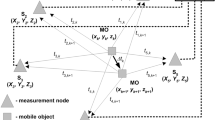Abstract
In this paper, we analyze the Observed Time Difference of Arrival (OTDOA) technique to simultaneously estimate the position of the different user equipments and the relative time difference between Node Bs in real UMTS networks. We concentrate on comparing two methods to solve the nonlinear system of equations, the well-known Gauss-Newton and the Levenberg-Marquardt algorithm. We show this latter method offers better results, providing faster convergence, higher accuracy and more robustness. Finally, a modification to the classical Levenberg-Marquardt algorithm is proposed in order to avoid divergences in that method.






Similar content being viewed by others
References
Gezici S (2008) A survey on wireless position estimation. Wirel Pers Commun 44:263–282
Huang J, Wan Q (2012) Analysis of TDOA and TDOA/SS based geolocation techniques in a non-line-of-sight environment. J Commun Netw 14:533–539
Schiller J, Voisard A (2004) Location-based services. Morgan Kaufmann, USA
Costa-Requena J, Tang H, Pozo IED (2001) SIP dealing with location based information. J Commun Netw 3:351–360
Sousa I, da Silva FS, Queluz P, Rodrigues A (2012) Location error spatial distribution in urban wireless cellular networks. Wirel Pers Commun 64:153–167
Horsmanheimo S, Jormakka H, Lähteenmäki J (2004) Location-aided planning in mobile network. Wirel Pers Commun 30:207–216
Laitinen H, Ahonen S, Kyriazakos S, Lähteenmäki J, Menolascino R, Parkkila S (2001) Cellular location technology. CELLO Consortium Technical Report. Available From http://telecom.ntua.gr/cello
3GPP (2003) Stage 2 functional specification of user equipment (UE) positioning in UTRAN; overall description 3GPP TS 25.305 V6.1.0
Stefanski J (2005) Simplified algorithm for location service for the UMTS. IEEE 62nd Vehicular Technology Conference, Dallas, pp 2741–2744
U̇beda C, Romero J, Ramiro J (2010) Evaluation of a time-delay based geolocation algorithm in real UMTS networks. Fifth International Conference on Broadband and Biomedical Communications (IB2Com), Málaga, pp 1–4
3GPP (2012) Synchronization in UTRAN stage 2. 3GG TS 25.402 V11.0.0 (Release 11)
Saadane R, Belkasmi M, Koutbi ME, Dadda M (2012) Evaluation of hybrid geo-location based on UMTS and GPS technologies. In: International Conference on Multimedia Computing and Systems (ICMCS). Tangiers, Morocco, pp 62–66
Mensing C, Plass S (2006) Positioning algorithms for cellular networks using TDOA. In: IEEE International Conference on Acoustics, Speech and Signal Processing. Toulouse, France, pp 513–516
Gustafsson F, Gunnarsson F (2005) Mobile positioning using wireless networks: possibilities and fundamental limitations based on available wireless network measurements. IEEE Signal Process Mag 22:41–53
Dennis J, Schnabel B (1983) Numerical methods for unconstrained optimization and non-linear equations. Prentice Hall in Computational Mathematics, Englewoods Cliffs
Quinten M (2011) Levenberg-marquardt algorithm. In: A Practical Guide to Optical Metrology for Thin Films. Wiley, pp 197–198
García-Fernández J, Jurado-Navas A, Fernández-Navarro M, Úbeda C (2015) Efficient star-topology solving local minima for geolocation in real UMTS networks: an experimental assesment with real data. Wirel Pers Commun 85:2115–2140
Zola E, Barcelo F (2006) About the location of base stations for a UMTS system: Analytical study and simulations. J Commun Netw 8:49–58
Acknowledgements
This work was supported by Ericsson.
Author information
Authors and Affiliations
Corresponding author
Rights and permissions
About this article
Cite this article
García-Fernández, J.A., Jurado-Navas, A., Fernández-Navarro, M. et al. A Comparative Study between Iterative Algorithms for TDOA Based Geolocation Techniques in Real UMTS Networks. Mobile Netw Appl 25, 1290–1298 (2020). https://doi.org/10.1007/s11036-017-0952-4
Published:
Issue Date:
DOI: https://doi.org/10.1007/s11036-017-0952-4




